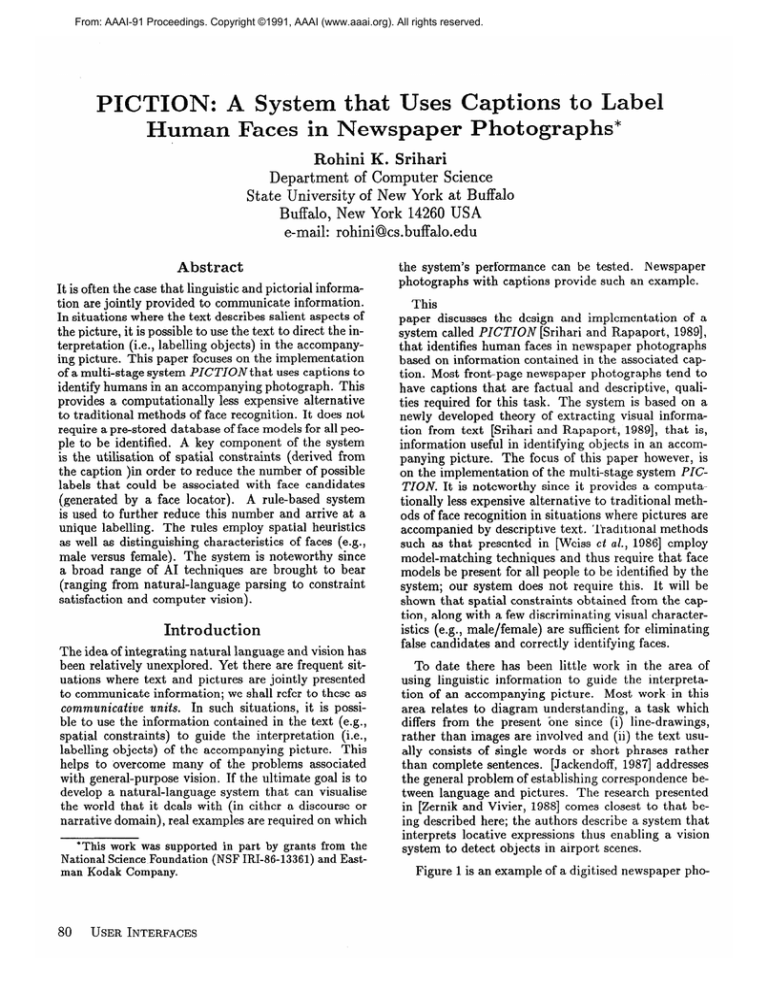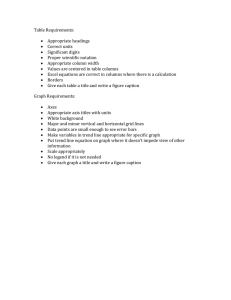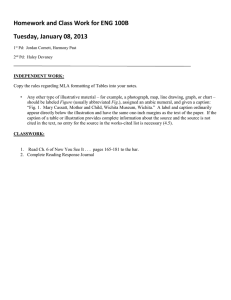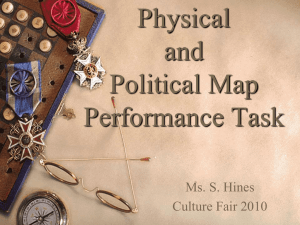
From: AAAI-91 Proceedings. Copyright ©1991, AAAI (www.aaai.org). All rights reserved.
ystem that Uses Captions to
PICTION:
A
Human Faces in Newspaper Photographs*
Rohini K. Srihari
Department of Computer Science
State University of New York at Buffalo
Buffalo, New York 14260 USA
e-mail: rohini@cs.buffalo.edu
Abstract
It is often the case that linguistic and pictorial information are jointly provided to communicate information.
In situations where the text describes salient aspects of
the picture, it is possible to use the text to direct the interpretation (i.e., labelling objects) in the accompanying picture. This paper focuses on the implementation
of a multi-stage system PICTION that uses captions to
identify humans in an accompanying photograph. This
provides a computationally less expensive alternative
to traditional methods of face recognition. It does not
require a pre-stored database of face models for all people to be identified. A key component of the system
is the utilisation of spatial constraints (derived from
the caption )in order to reduce the number of possible
labels that could be associated with face candidates
(generated by a face locator).
A rule-based system
is used to further reduce this number and arrive at a
unique labelling. The rules employ spatial heuristics
as well as distinguishing characteristics of faces (e.g.,
male versus female). The system is noteworthy since
a broad range of AI techniques are brought to bear
(ranging from natural-language parsing to constraint
satisfaction and computer vision).
Introduction
The idea of integrating natural language and vision has
been relatively unexplored. Yet there are frequent situations where text and pictures are jointly presented
to communicate information; we shall refer to these as
communicative units. In such situations, it is possible to use the information contained in the text (e.g.,
spatial constraints) to guide the interpretation (i.e.,
labelling objects) of the accompanying picture. This
helps to overcome many of the problems associated
with general-purpose vision. If the ultimate goal is to
develop a natural-language system that can visualise
the world that it deals with (in either a discourse or
narrative domain), real examples are required on which
*This work was supported in part by grants from the
National Science Foundation (NSF IRI-86-13361) and Eastman Kodak Company.
80
USER INTERFACES
the system’s performance can be tested. Newspaper
photographs with captions provide such an example.
This
paper discusses the design and implementation of a
system called PICTION [Srihari and Rapaport, 19891,
that identifies human faces in newspaper photographs
based on information contained in the associated caption. Most front-page newspaper photographs tend to
have captions that are factual and descriptive, qualities required for this task. The system is based on a
newly developed theory of extracting visual information from text [Srihari and Rapaport, 19891, that is,
information useful in identifying objects in an accompanying picture. The focus of this paper however, is
on the implementation of the multi-stage system PICTION. It is noteworthy since it provides a computationally less expensive alternative to traditional methods of face recognition in situations where pictures are
accompanied by descriptive text. Traditional methods
such as that presented in [Weiss et al., 19861 employ
model-matching techniques and thus require that face
models be present for all people to be identified by the
system; our system does not require this. It will be
shown that spatial constraints obtained from the caption, along with a few discriminating visual characteristics (e.g., male/female) are sufficient for eliminating
false candidates and correctly identifying faces.
To date there has been little work in the area of
using linguistic information to guide the interpretation of an accompanying picture. Most work in this
area relates to diagram understanding, a task which
differs from the present one since (i) line-drawings,
rather than images are involved and (ii) the text usually consists of single words or short phrases rather
than complete sentences. [Jackendoff, 19871 addresses
the general problem of establishing correspondence between language and pictures. The research presented
in [Zernik and Vivier, 19881 comes closest to that being described here; the authors describe a system that
interprets locative expressions thus enabling a vision
system to detect objects in airport scenes.
Figure 1 is an example of a digitised newspaper pho-
Mayor
”
’
(b)
Coleman Young of Detroit, right, at an N.A.A.C.P. dinner last
Figure 1: (a) Digitised photograph whose caption is “
.
week. With the Mayor were Michael Illitch, owner of the Detroit Red Wings, and his wife, Marian (The New York Times,
May 1, 1989). (b) f ace candidates (c)-(e) output of PICTION.
tograph and accompanying caption that the system
can handle. The system attempts to isolate and label
those parts of the image that correspond to the faces of
Mayor Coleman, Michael Illitch and his wife Marian.
It should be noted that in this example, the caption asTo
sumes that the reader can distinguish between Michael
and his wife, and hence they
Mayorare not identified explicitly. Furthermore, there are two other people in the
picture who are not identified in the caption” and it is
a challenge for the system to select the correct three
people.
System
Overview
A multi-stage system (illustrated in 2) is employed in
order to carry out the task of identification. The system consists of three main processing modules, namely
‘
simplify the parsing process, the two sentences
of the caption were combined into one (not affecting the
Coleman Young of Detroit, right, with
meaning) : “
Michael Illitch, owner of the Detroit Red Wings, and his
wife Marian at a dinner last week
the Vision module, the NLP (Natural Language Processing) module and the Interpretation module. The
first step consists of parsing the caption and producing
the conceptualised graph which reflects factual information contained in the caption as well as predictions
regarding the composition of the picture. The interpretation module (i) ca 11s on the vision module to first
generate candidates for faces in the image (Figure lb),
(ii) uses the spatial constraints in the conceptualised
graph to form initial hypotheses about name-face correspondences and (iii) invoke a rule-based system to
narrow down the set of hypotheses based on visual
characteristics of the people being identified. Eventually, the interpretation module generates a list of
coordinate-name pairs, representing name-face correspondences. This information is consolidated into the
original graph producing the consolidated graph. From
this, the system is able to produce the desired pictorial
output. Each of these stages are discussed in greater
detail.
SRIHARI
81
._.-----__---____-__----------------
,
jj
c
,
(no.offacacandidaks)
‘9
INTERMEDIATE RFPRE!SENTATION
Figure 2: PICTION:
Processing
the Caption
(NLP
Module)
The process of interpreting the caption has two main
goals. The first is the representation of the factual information contained in the caption. This is explicit
information provided by the caption, namely the identification of the people in the photograph and the context under which the photograph was taken. More
important for our application, however, is the second goal, the construction of a conceptualised graph
representing the expected structure of the picture.
The conceptualised graph includes information such
as the objects hypothesised to be in the picture, their
physical appearance, and spatial relationships between
them. We use the SNePS (Semantic Network Processing System) knowledge-representation and reasoning system to represent both factual information and
the conceptualised graph derived from the caption
[Shapiro and Rapaport, 19871. SNePS is a fully intensional, propositional, semantic-network processing system in which every node represents a unique concept.
It can perform node-based and path-based inference
and it also provides a natural-language parsing and
generating facility.
We are interested in two aspects of visual information provided by the caption. These are (i) information
allowing an NLP system to predict which people mentioned in the caption are present in the picture, and
(ii) information necessary for identifying these individuals. Captions frequently refer to people who are not
present in the picture as in “Gov. Cuomo and his wife,
Matilda, walk up the church steps to attend the mar82
USER INTERFACES
System Overview
riage of their son Andrew to Kerry Kennedy, daughter
of Ethel Kennedy and the late Robert F. Kennedy”
(The Buflulo News, June 10, 1990). Sentence type
plays an important role in determining which people
are present in the picture. We have also observed that
any person referred to using a time other than the event
time (the time picture was taken) is not in the picture. This phenomena is marked linguistically through
the introduction of relative clauses beginning with the
words ‘before’, ‘after’, ‘as’, etc. We also stress the
importance of correctly predicting the class of an object. This is illustrated by the caption “Marge Schott,
. . . gets a farewell hug from Buster T. Bison, the Buffalo Bisons’ mascot . . .” (The Bu&do News, May 15,
1990) accompanying a picture of a woman and a toy bison. A simplistic parser could mistake Buster T. Bison
to be a human causing the face identification system
to be led astray.
Specifying spatial relations between objects is the
principal method of identification. The caption often
explicitly specifies the spatial relation, as in “Thomas
Walker, left, John Roberts, center . . .” thus making
the task relatively simple. A more complex form of
identification involves the use of visual detail (e.g.,
“Tom Smith, wearing a top hat . . . “). A subtle version
of this type of identification can be observed in captions
that require the system to distinguish between one or
more people based on gender or class information (e.g.
“Amy Jones, 9, poses with a clown at the circus”). It
is assumed that the reader can distinguish between the
clown and Amy Jones.
Many captions combine implicit and explicit means
Figure 3: Partial output of the parser on caption of Figure 2
of identification such as that in Figure 1. The system
is able to handle such cases correctly. Figure 3 illustrates a portion of the SNePS network resulting from
the processing of the caption in Figure 1 upto and including this stage. In Figure 3, node M95 serves as a
link between the visual-model describing the composition of the picture (node B17), and factual information
contained in the caption (node M76). Considering the
linguistic information first, node M76 asserts that the
people in the set denoted by node M71, (comprised of
nodes B8, B9 and Bll), are present at a certain place
(node M73) and time (node M74). Furthermore, node
B8 represents the concept of the person named Coleman Young, node B9 represents Michael Illitch (not
illustrated), and node Bll represents Michael’s wife
Marian.
Turning to the portion of the SNePS network representing derived visual information, nodes B15, B18
and B20 are the individual visual models for Coleman
Young, Marian and Michael Illitch respectively. Nodes
M83, M87 and M91 assert the presence of these objects
in the visual-model for the entire picture (node B17).
Nodes M92, M93 and M94 assert spatial relations between the visual-models for the 3 people. Nodes M93
and M94 specify that Marian and Michael Illitch are
to the left of Coleman Young. Node M92 asserts that
Marian and Michael are adjacent to each other. The
latter is a weak spatial constraint but is the only one
that can be inferred since we cannot assume that the
order of mention in the caption reflects the left-to-right
ordering in pictures (where there is a combination of a
male and female).
Vision
Module
The vision module in this system performs two main
functions. The first is the task of locating candidates
for faces, and the second is the characterisation of
faces. From the caption, we are able to determine
the number of faces and some weak bounds on the
size of faces. These constitute parameters to the facelocation module [Govindaraju et al., 19891. Since the
face-locator is still under development at this stage,
the output is simulated based on a thinned-edge image. For each image area hypothesised to be a face, this
module returns the coordinates of a bounding rectangle
for that area. The simulated output exhibits realistic
problems since false candidates are generated due to
incidental allignment of edges and true candidates are
occasionally missed due to poor edge data. Simulated
output on the image of Figure l(a) is shown in Figure
l(b). The spurious candidates (c4 and c8), are due to
incidental alignment of edges, in the desired pattern,
along the sleeve lengths of Marian and Michael Illitch.
SRIHARI
83
In general, the vision module is required whenever it
becomes necessary to examine in detail the portion of
the original image (i.e., the photograph) corresponding to a box representing a face candidate. The vision
module is expected to make some qualitative judgement about this area. The process used to make each
of these judgements will be referred to as a “filter”.
Specifically, the vision module is called on to verify
visual characteristics that may be useful in the identification process. The visual characteristics that are
being used currently are male versus female, baldness
and colour (black/white).
It is these filters that enabled the successful processing of the example presented in Figure 4. The system
identifies and labels Bush and Ford- even though the
caption might lead a machine to believe that Ford was
on the left. The system is told in advance that Ford is
bald. It applies the “baldness” filter to all face candidates and is able to select the one which best matches.
This filter is based upon finding minima (of a specified depth, width and position) in vertical profiles (of
the top one-third rows only) of face candidates. The
male/female filter was applied successfully in the picture of Figure 1 in order to distinguish between Michael
Illitch and Marian.
Interpretation
Module
An interpretation strategy for the picture is a systematic method of using information in the hypothesised structure to find relevant objects and spatial
relationships in the picture. At this point, the interpretation strategy is implicitly embedded in the main
control structure of the system and consists of three
steps: (i) face location, (ii) constraint satisfaction and
(iii) rule-based identification. Each of the above three
steps necessitates the use of the vision module. We
have already discussed the function of the face locator. The final output of the rule-based identification
system is incorporated into the intermedidate representation (the SNePS network), thus completing the
face-identification task.
In general, the location
procedure generates more candidates than required
(Figure lb). Spatial constraints (obtained from the
caption) are applied to the candidates generated by
the face-locator to produce all possible bindings. A
labeling algorithm [Haralick and Shapiro, 19791 is employed which uses a look-ahead operator in order to
eliminate backtracking in the treesearch. A “binding”
represents the assignment of correspondence between
face candidates and people predicted to be in the picture.
Constraint
Satisfaction
Rule-Based
Face Identification
Because a large
number of candidates are generated by the face locator, spatial constraints alone cannot produce a unique
binding between candidates and people mentioned in
the caption. Furthermore, a spatial constraint such as
84
USER INTERFACES
“adjacent” (used frequently in male-female pairs) will
produce at least two possibilities. The rule-based face
identification module-evaluates the bindings produced
by the constraint satisfier and selects the best one(s).
We refer to each of the tuples in a binding as a
“match”. The refinement and identification rules fall
into three categories: (i) those that update the confidence of a candidate being a face (irrespective of which
person that face is associated with), (ii) those that
update the confidence of a “match” , i.e. the confidence that a particular face candidate corresponds to
a named person and (iii) those that update the confidence of an entire binding. An example of a candidate
rule is one that examines the centrality of the face candidate in the image. Most of the match rules involve
checking for distinguishing visual characteristics of a
face. For example, if the match associates a face candidate with a person who is known to be bald, it invokes
the “baldness” filter on this face candidate in order to
verify the match. An example of a binding rule is one
which examines height relationships between people in
the same row. It favours those bindings where the vertical positions of faces do not differ significantly.
Currently, we are using a hierarchical Bayesian UPdating scheme to combine evidence from rules supporting the same hypothesis. Assuming that we are able
to generate the three types of confidences described
above, the weight of a match, weightmatchi is computed as confidence,zi
t confidence,,t,hi.
We assign a weight W to every binding B, such that W =
weightmatchi] *confidenceB where confidenceB
KL
is the confidence associated with the binding itself.
If the weight of bindings differ by less than a preset
threshold, thresh, then they are considered equivalent.
This creates multiple correspondences for some or all
of the faces. Based on experimental results, a value of
thresh optimising both accuracy and uniqueness was
selected. - In cases where the system cannot uniquely
identify faces, all possible candidates for each person
appearing in the caption are recorded.
Testing
System
and Evaluating
Results
The system was trained on a dataset of 50 pictures
and captions obtained from The Bu&Zo News and The
New York Times. There are three success codes used
to evaluate the system: (a) SU (success), indicating
that everyone identified in the caption is identified by
the system correctly and uniquely; (b) PS (partial success), indicating multiple possibilities for one or more
people where the actual face is included and (c) E (error), indicating that one or more people was identified
incorrectly (i.e., true face not included). An overall
success rate (i.e. SU only) of 65 percent was obtained.
The most common reason for a result of PS or E was
the failure of the face locator to locate one or more of
the identified faces. In only one case, the error was
due to an incorrect parsing. Other reasons for a result code of PS or E included (i) the failure of spatial
President Gerald Ford joins George Bush at rally in Royal Oak Michigan
Figure 4: (a) photograph with caption “
(The BPr$alo News, Oct. 19, 1988).(b) output of face-locator (c,d) output of PICTION
heuristics (ii) inability to properly characterise faces
(e.g., male/female, young/old).
Summary
We have presented a new method of face recognition
in situations where pictures are accompanied by descriptive text. It is based on a new theory addressing
the issue of extracting visual information from text.
has been described,
A multi-stage system PICTION
which uses an intermediate representation referred to
as a conceptualised graph in order to consolidate information (i) obtained from parsing the caption and
(ii) information obtained from picture processing. The
system is noteworthy since it does not require a prestored database of face models for all faces that are
to be recognised. The results based on a limited testing of the system, illustrate the viability of this approach as an alternative to traditional methods of facerecognition. Future work includes the enhancement
of filters that characterise faces, the ability to process
more complex type of visual information and finally,
extensive testing of the system.
References
Govindaraju, Venu; Sher, David B.; Srihari, Rohini K.;
and Srihari, Sargur N. 1989. Locating human faces in
newspaper photographs. In Proceedings of CVPR. 549554.
Haralick, Robert M. and Shapiro, Linda G. 1979. The
Consistent Labeling Problem: Part 1. IEEE Trtansactions
on Pattern Analysis and Machine Intelligence
PAMI1(2):173-184.
Jackendoff, Ray 1987. On Beyond Zebra: The Relation
of Linguistic and Visual Information Cognition 26(2):89114.
Shapiro, Stuart C. and Rapaport, William J. 1987. SNePS
Considered as a Fully Intensional Propositional Semantic
Network. In Cercone, Nick and McCalla, Gordon, editors
1987, The Knowledge Frontier, Essays in the Representation of Knowledge. Springer-Verlag, New York. 262-315.
Srihari, Rohini K. and Rapaport, William J. 1989. Integrating Linguistic and Pictorial Information: Using Captions to Label Human Faces in Newspaper Photographs.
In Proceedings of the 11th Annual Conference of the Cognitive Society. Lawrence Erlbaum Associates. 364-371.
Weiss, Richard; Kitchen, Leslie; and Tuttle, Julianne
1986. Identification of Human Faces Using Data-driven
Segmentation, Rule-based Hypothesis Formation and Iterative Model-based Hypothesis Verification.
COINS
Technical Report 86-53, University of Mass. at Amherst.
Zernik, Uri and Vivier, Barbara J. 1988. How Near Is
Too Far? Talking about Visual Images. In Proceedings
of the Tenth Annual Conference of the Cognitive Science
Society. Lawrence Erlbaum Associates. 202-208.
SRIHARI
85



